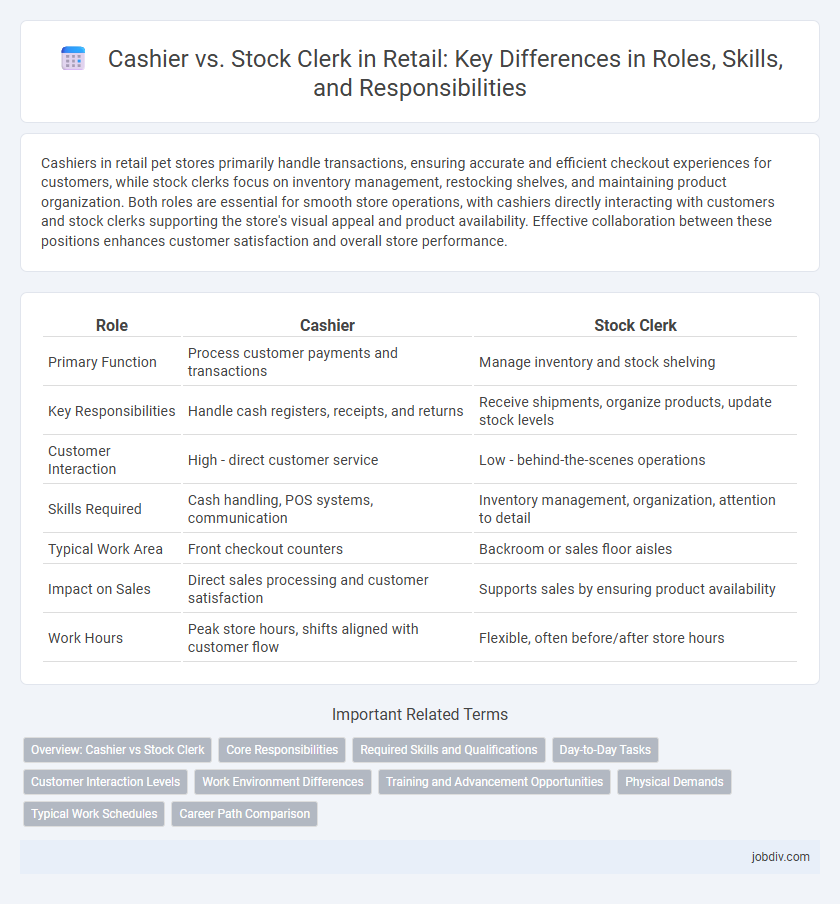Cashiers in retail pet stores primarily handle transactions, ensuring accurate and efficient checkout experiences for customers, while stock clerks focus on inventory management, restocking shelves, and maintaining product organization. Both roles are essential for smooth store operations, with cashiers directly interacting with customers and stock clerks supporting the store's visual appeal and product availability. Effective collaboration between these positions enhances customer satisfaction and overall store performance.
Table of Comparison
| Role | Cashier | Stock Clerk |
|---|---|---|
| Primary Function | Process customer payments and transactions | Manage inventory and stock shelving |
| Key Responsibilities | Handle cash registers, receipts, and returns | Receive shipments, organize products, update stock levels |
| Customer Interaction | High - direct customer service | Low - behind-the-scenes operations |
| Skills Required | Cash handling, POS systems, communication | Inventory management, organization, attention to detail |
| Typical Work Area | Front checkout counters | Backroom or sales floor aisles |
| Impact on Sales | Direct sales processing and customer satisfaction | Supports sales by ensuring product availability |
| Work Hours | Peak store hours, shifts aligned with customer flow | Flexible, often before/after store hours |
Overview: Cashier vs Stock Clerk
Cashiers primarily handle customer transactions, process payments, and manage cash registers, ensuring accurate and efficient checkout experiences in retail settings. Stock clerks are responsible for inventory management, including receiving shipments, organizing stock, and replenishing shelves to keep store merchandise well-stocked and accessible. Both roles are crucial for smooth retail operations, with cashiers focusing on customer interaction and stock clerks maintaining product availability.
Core Responsibilities
A cashier primarily handles customer transactions, processes payments, issues receipts, and manages cash registers efficiently to ensure smooth sales operations. Stock clerks focus on inventory management by receiving, organizing, and replenishing merchandise on shelves to maintain optimal stock levels. Both roles are critical in retail environments for enhancing customer experience and maintaining operational flow.
Required Skills and Qualifications
Cashiers require strong communication skills, basic math proficiency, and customer service experience to efficiently process transactions and handle inquiries. Stock clerks need physical stamina, organizational abilities, and knowledge of inventory management systems to maintain stock levels and arrange products on shelves. Both roles demand attention to detail and reliability, but cashiers emphasize interpersonal interaction while stock clerks focus on logistics and stock control.
Day-to-Day Tasks
Cashiers primarily handle customer transactions, scanning items, processing payments, and providing receipts, ensuring a smooth checkout experience. Stock clerks focus on inventory management, including receiving deliveries, restocking shelves, and organizing backroom storage to maintain product availability. Both roles are essential for efficient store operations, balancing customer service with inventory control.
Customer Interaction Levels
Cashiers engage directly with customers, handling transactions and addressing immediate inquiries, enhancing customer satisfaction through personal interaction. Stock clerks have limited customer contact, focusing primarily on inventory management and replenishment to ensure product availability. The varying levels of customer interaction influence the roles' impact on overall customer experience in retail environments.
Work Environment Differences
Cashiers typically work at checkout counters in high-traffic areas, interacting directly with customers and handling payment transactions in fast-paced retail environments. Stock clerks operate in storage rooms and sales floors, focusing on inventory management, restocking shelves, and organizing merchandise away from front-end customer areas. These distinct work environments impact their daily tasks, noise levels, and customer interaction intensity within retail settings.
Training and Advancement Opportunities
Cashiers typically receive focused training on point-of-sale systems, customer service, and basic financial transactions, enabling quick mastery for entry-level positions. Stock clerks undergo training centered on inventory management, product organization, and supply chain logistics, developing skills crucial for retail operations and warehouse roles. Advancement opportunities for cashiers often lead to supervisory roles or sales management, while stock clerks can progress into inventory control, logistics coordination, or store management positions.
Physical Demands
Cashiers primarily perform repetitive tasks such as scanning items, handling cash transactions, and standing for long periods, requiring fine motor skills and endurance. Stock clerks engage in more physically demanding duties including lifting heavy boxes, restocking shelves, and organizing inventory, often involving frequent bending, lifting, and carrying loads up to 50 pounds. The physically intensive nature of stock clerks' roles typically results in greater overall strain compared to the repetitive but less strenuous duties of cashiers.
Typical Work Schedules
Cashiers often work flexible shifts including evenings, weekends, and holidays to accommodate peak store hours and customer traffic, typically covering part-time or full-time schedules. Stock clerks usually have early morning or overnight shifts to restock shelves before store opening or after closing, with schedules that may include weekends and occasional overtime. Both roles require adaptability, but cashiers tend to have more variable hours influenced by customer demand while stock clerks have more consistent, task-focused time blocks.
Career Path Comparison
Cashiers typically begin their retail careers managing point-of-sale transactions and customer interactions, gaining skills in handling cash and electronic payments, which can lead to supervisory roles or training positions. Stock clerks focus on inventory management, including receiving shipments, organizing products, and maintaining stock levels, often advancing to inventory control or warehouse management. Both paths offer opportunities for growth within retail operations but differ in skill specialization and career trajectory.
Cashier vs Stock Clerk Infographic

 jobdiv.com
jobdiv.com